Here’s my third and final post of pictures from Geneva and Paris today—but first a few announcements before our scheduled show.
I’m into resurrecting my archives these days, and I’ve been moving a number of my old videos onto my YouTube channel.
Recent additions include a “Brain Food” playlist: six videos of me talking about books and art, on public access TV in 1986 Lynchburg, VA…which was then the home of the right-wing Moral Majority religious movement. Seeds of transrealism, computer culture, and cyberpunk—all are here.
Another new video upload is “James Gleick’s CHAOS: the Software.” I made this video in 1990 to demonstrate the 1990 Autodesk program of the same name. The program was written by me, Josh Gordon, and John Walker. Topics include dynamical systems, strange attractors, Mandelbrot set fractals (including a 4D cubic version), cellular automata, and fractal landscapes. The software is available as a free download, although you need to screw with a free helper program called DOSBox in order to get it to run on today’s machines (Unix, Mac, or Windows all can be made to work).
One more scrap of hype: my story “Attack of the Giant Ants” went online at the Motherboard site today, as part of their SF-oriented ezine section called Terraform, which is edited by Claire Evans.
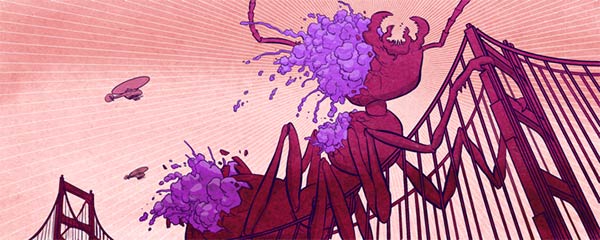
The story has a wonderful illo by Koren Shadmi.
If you want, you can hear me reading the story online as well:
My story was inspired by two things: Blondie’s song, “The Attack of the Giant Ants,” and the primeval SF movie Them. There’s exists an amateur YouTube video combining these two—although the sound’s not all that great, so listen to the Blondie song elsewhere as well. The roaring of the ants at the end of the Blondie song is particularly great.
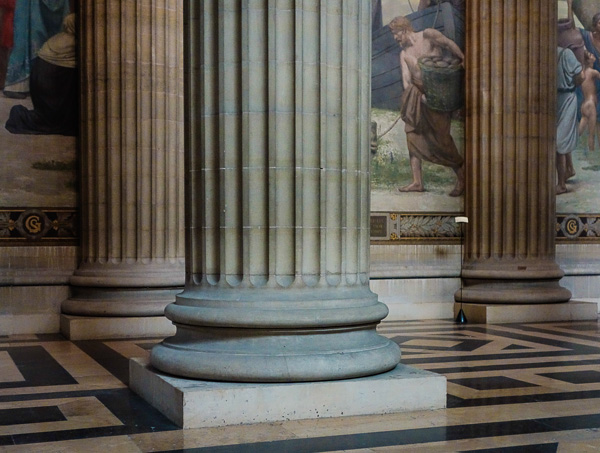
And now let’s move back into the higher real of Parisian art and architecture. Here’s three of the insanely large columns within the Pantheon. I like how the lighting happened to put different shades onto them.
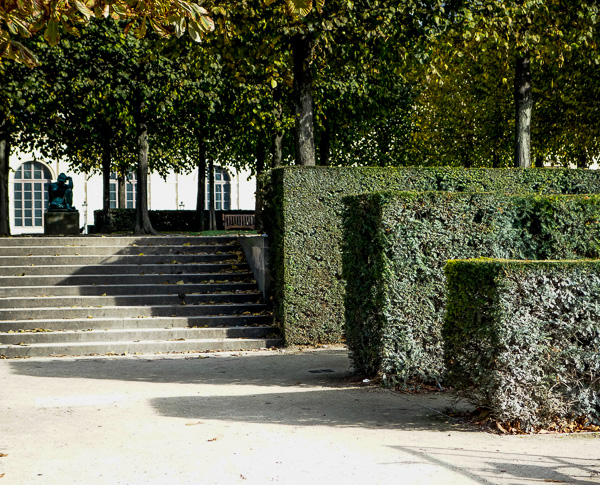
The crowds were such that Sylvia and I didn’t try going inside the Louvre, but we wandered around the nearby section of the Tuileries gardens. Love these receding box hedges. Like scrims on a stage set.
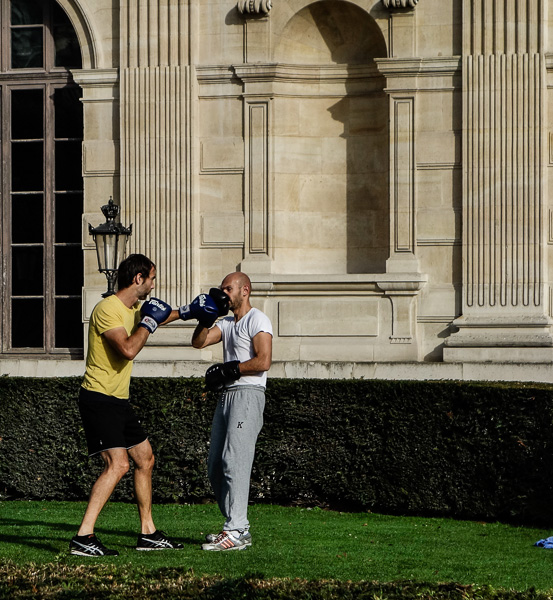
On a little plot of grass we found two men boxing. It made me think of Hemingway trying to get his friends to box with him back in his 1920s Paris days. Who would want a friend like that? He was so crazy. But even so a lovely writer. The stories of In Our Time and the first pages of A Farewell to Arms still live in my memory.
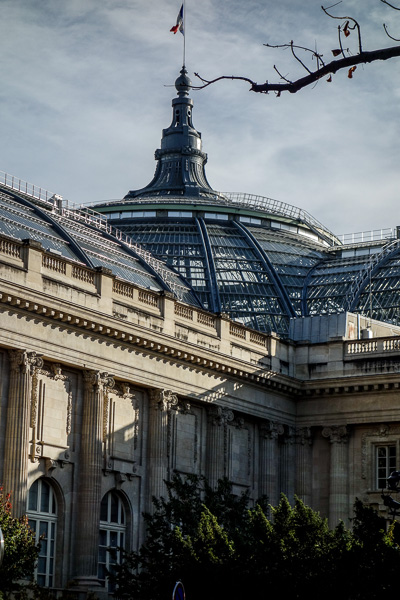
The size of the buildings they used to undertake. I mean, we think we build big stuff now. But… I think this one is the Grand Palais, which is a museum now as well. Here, too, the lines were such that we couldn’t get in. And newly renovated Picasso Museum was out of the question. Even in late October. Thing is, there’s twice as many people on Earth as there were when I was younger.
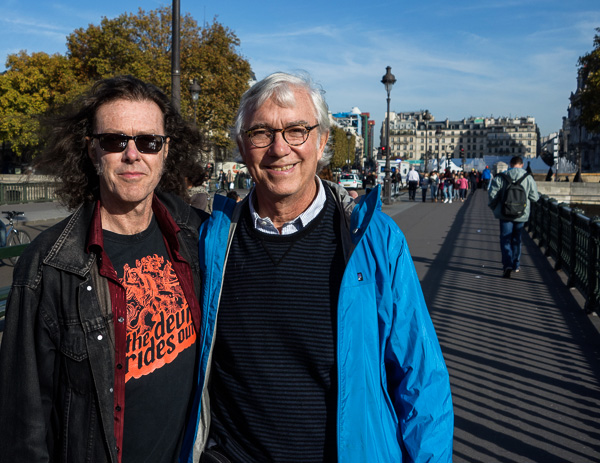
Our friend Leon Marvell from Melbourne, Australia, turned out to be in Paris, leading a group of college kids on a trip—Sylvia noticed this fact on Facebook. So we spent a day with Leon, a lot of fun. He and I once published a paper together, called “Lifebox Immortality—and How We Got There.”
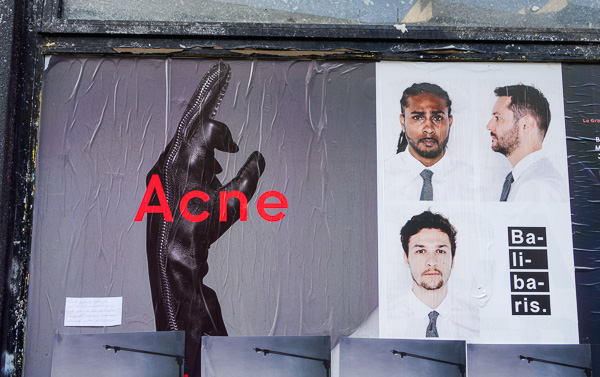
We made our way over to the Beaubourg art museum, passing this cool ad on the way. What a concept, calling your couture company Acne. There’s this thing with using words from a language that’s foreign to you—the words don’t carry the onus that they might to a native speaker. Note the Acne hand in the zippered glove is giving the Finger.
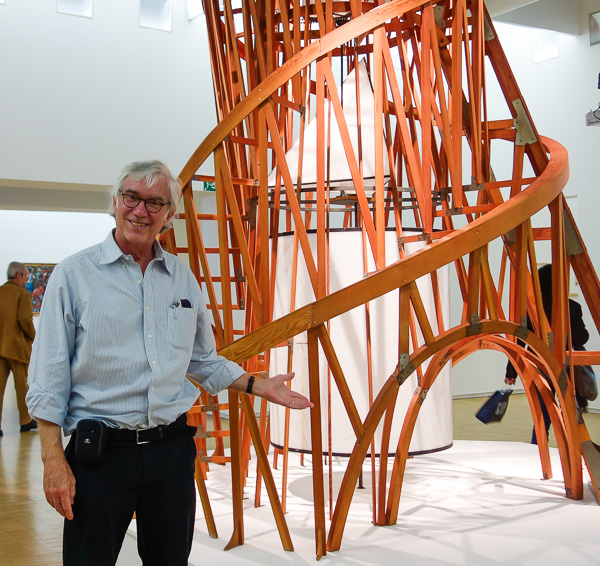
There was no line at all to get into the Beaubourg—it’s a huge place, a more contemporary museum than the Louvre or the Quai d’Orsay, and not so much of a bees-on-honey kind of a scene, tourist-wise. I found one of my favorite constructions still there, a model of Vladimir Tatlin’s, Monument to the Third International. If you want more info about this object, check out my SF story of the same name from 1983, a mere thirty-one years ago. Who knows where the time goes.
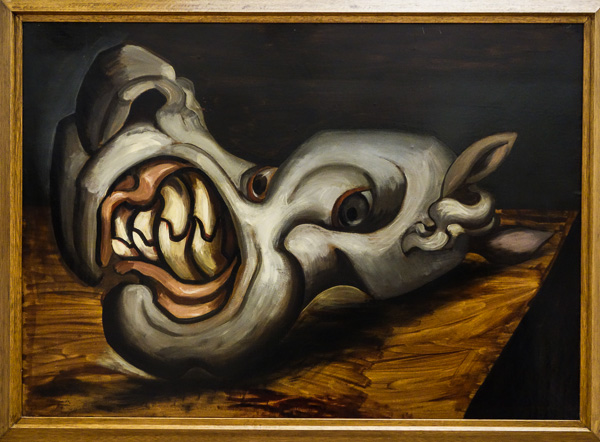
This is a cool cubist painting of a wolf—I can’t remember the artist’s name, could it have been Francis Picabia? [No, it’s Luis Fernandez, and it’s not a wolf, it’s a “Head of a Dead Horse.” My quondam partner in crimes against good taste and against po-faced solemnity, Paul Di Filippo, unearthed this fact with a Google image search, leading to the painting’s page at Beaubourg.]
I’ve always had an itchy fascination with cubism, like never quite fully getting what the underlying idea of it is—of course looking at explanations written by painters is not going to be all that illuminating in a context like this. There’s also a whiff of cubism having to do with the fourth dimension—see the article on Wikipedia, also my friend Linda Dalrymple Henderson wrote a good book on this topic.
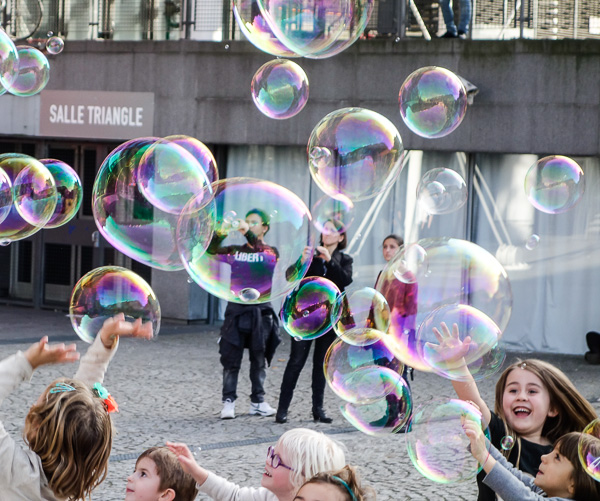
There’s always a real scene outside the Beaubourg—lots of people sitting on the ground, most of them young, along with various street performers. A guy was making giant bubbles, and a swarm of kids was running around. Another story link: my 1980 tale “The Indian Rope Trick Explained,” is set exactly in this spot. So many memories in dear Paris.
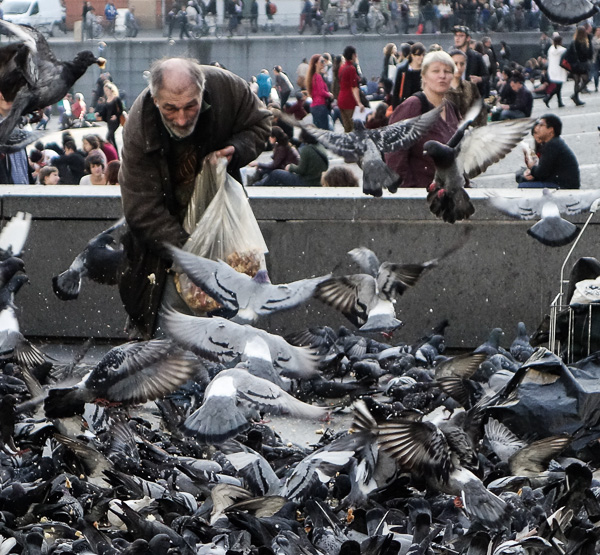
A bum was distributing great sacks of bread to thousands of flocking pigeons. As a private joke to myself, I pretended that this man was my old pal Greg Gibson. Greg in Paris.
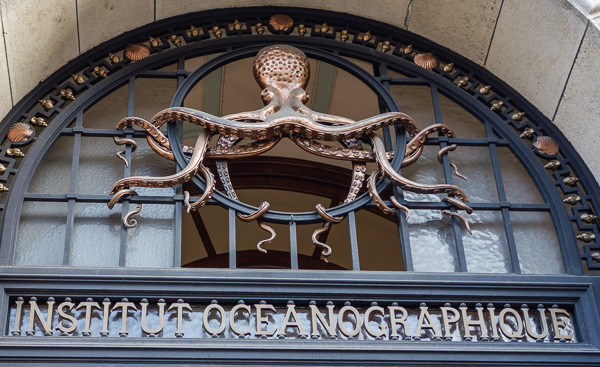
Wandering around the neighborhood of our hotel and the Pantheon, I came across the Oceanographic center, with am imposing sculpture of an octopus.
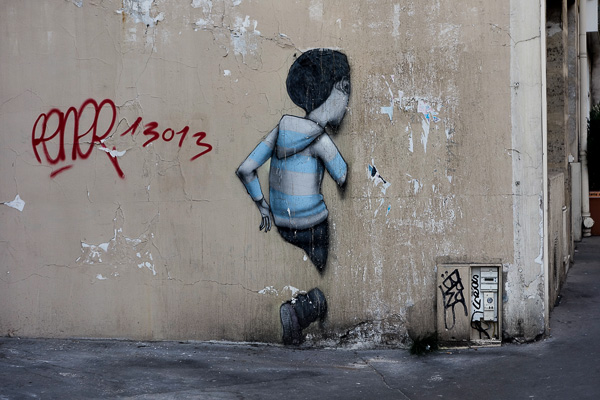
Also a really cool and surreal graffito of a boy walking through a wall.
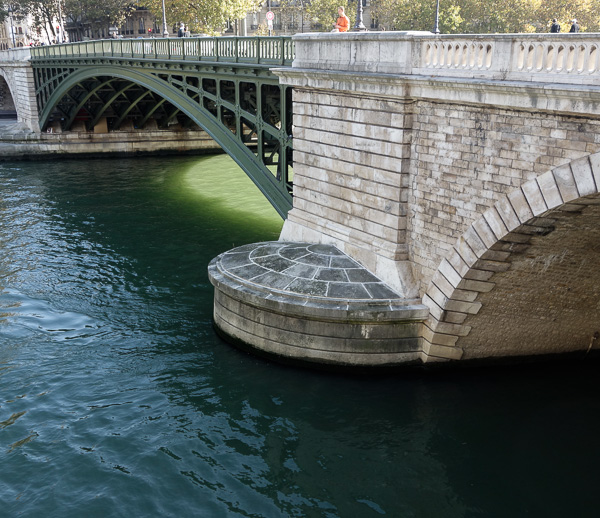
By the end of our stay, our legs were exceedingly tired, and we were moving very slowly. I took a little walk around the Isle de St. Louis, a tiny residential island in the Seine. It’s a spot that’s always interested me, especially the river’s-edge walkways around it.
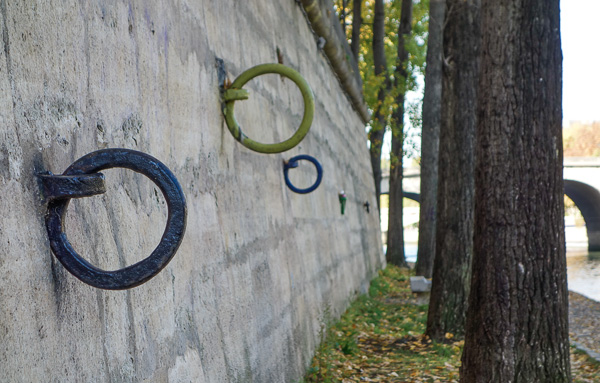
I found some cool hawser-tying rings in the walls down there. Also I dropped my pen into the water, something of a tragic experience for me, watching my good pen drift away—it would take me nearly a whole day to find another one. You can’t exactly buy a pen from a tourist shop; pens like that barely even write. But even without my pen, I had my camera.
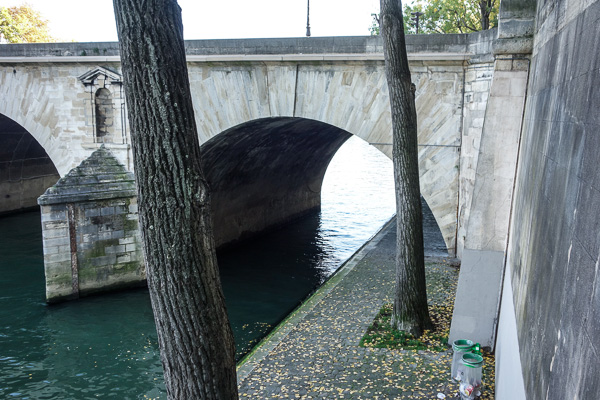
It was quiet down by Seine at the edge of the Ile de Saint Louis. Loved it. Felt like I was truly on vacation from my life. What you want from a trip.
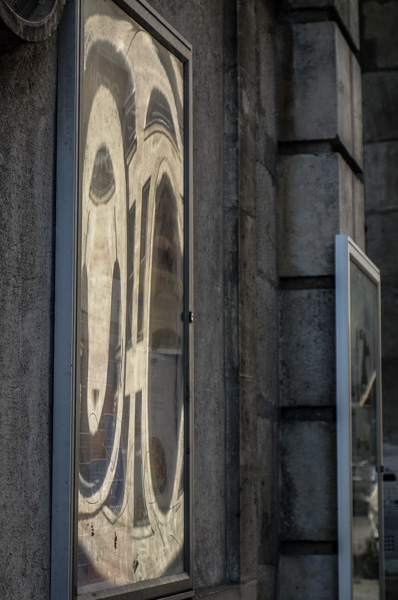
Up on the cobblestone streets I spotted a really nice reflection in a flat window. As a mathematician and an SF writer, an image like this totally gets to me. The smooth deformation of reality within a magic mirror.
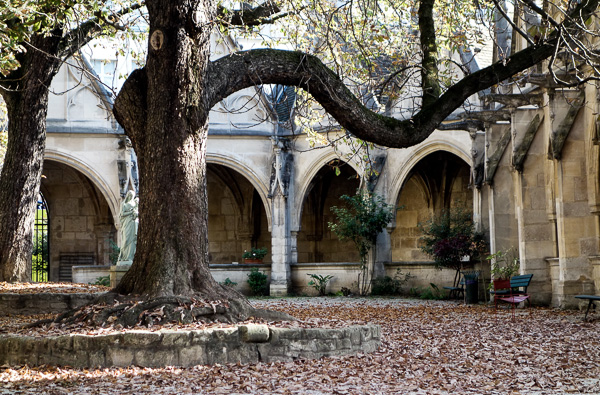
I met up with Sylvia again, and we went by this church from, like, the 1400s. Dig the curve of that tree branch. Later that evening, we came back here and heard an organ concert. Love those free church concerts in Paris.
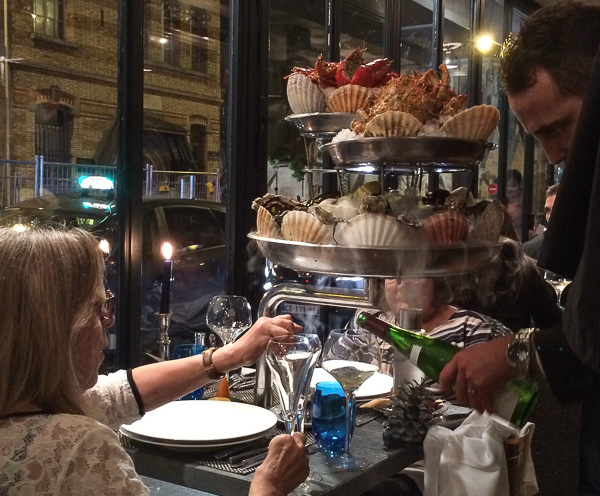
After the concert, we stopped by an oyster place where we’d gone about twenty years before. It wasn’t really what it used to me, much more commercialized, with the menus on frikkin’ iPad-like devices, and the oysters not overly fresh. But fun to see these two jolly ladies next to us who ordered the “Triple Royal Platter,” with three levels of crushed-ice-plus-dry-ice trays bearing the fruits of the sea. Washing it down with champagne.
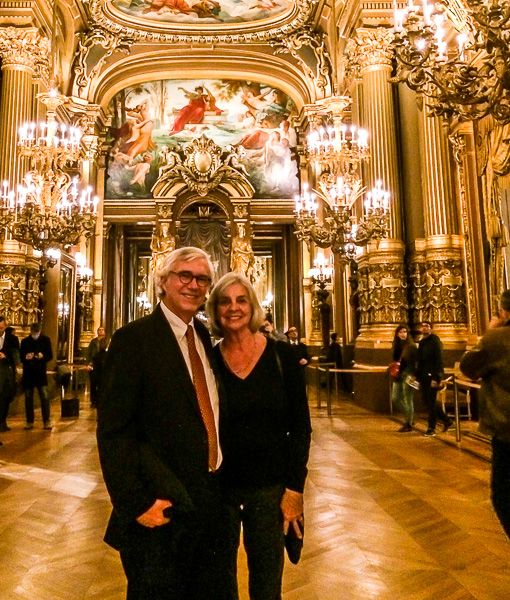
The next night, for a final treat, we caught a ballet at the old Palais Garnier, which holds the Paris opera. Remember us like this…










December 14th, 2014 at 4:24 pm
As I read this latest report, many things popped into and out of my head… will have to come back and re-think it all. Photos as always: *excellent*.
For now, let’s just say that I’m glad you didn’t fall off the bridge because if you had, you would have gone in Seine!
December 17th, 2014 at 2:01 pm
What a lovely couple, just as I remember!